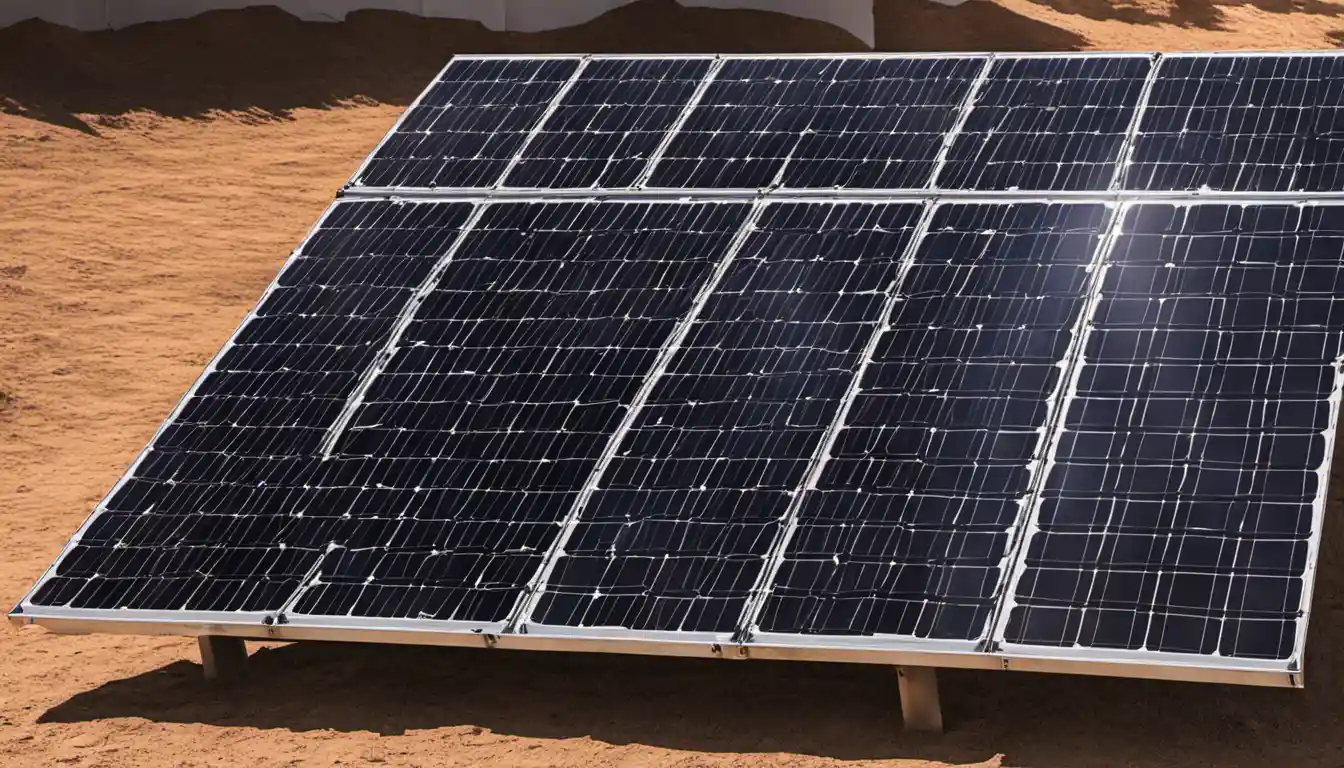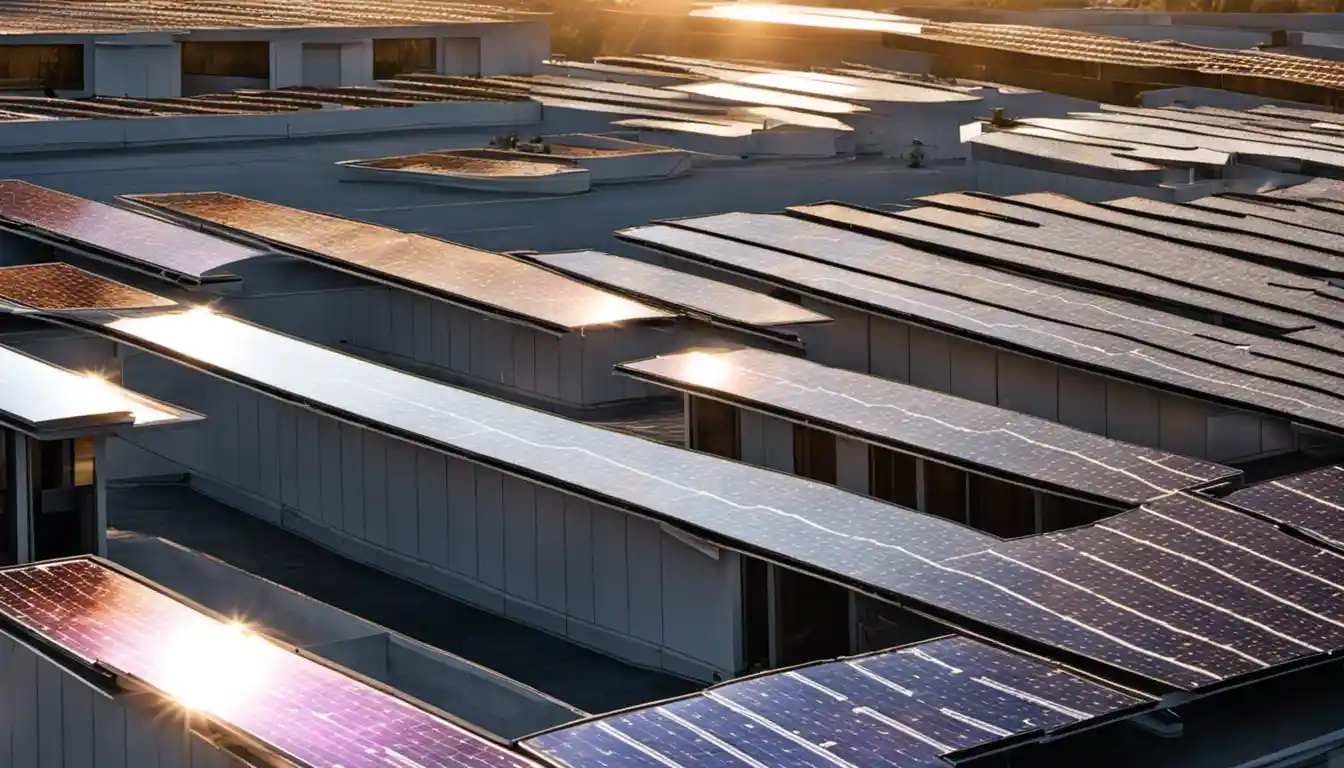Understanding Solar Panels: What are They
Solar panels come in various sizes depending on their wattage or power output. A common residential solar panel size is approximately 65 inches by 39 inches, and typically has a power output of around 300 watts. Larger panels, more common in commercial and industrial installations, can be over 78 inches by 39 inches and produce more than 400 watts.
The Technology behind Solar Panels
Solar panels, the unsung heroes of renewable energy! With our ever-growing focus on sustainability, these extraordinary pieces of technology allow us to convert sunlight directly into electricity utilizing a fascinating process called the photovoltaic effect.
See also: Solar Panel VMP vs VOC (Important Practice)
How Solar Panels Work
Every solar panel is structured with numerous solar cells or Photovoltaic (PV) cells, which are like tiny factories transforming sunlight into power. When the sunlight hits the PV cells, it triggers a whirlwind of electrons. This commotion sets up an electric field across the cells, causing electricity to flow – it’s affordable, green, and incredibly effective!
See also: 12V Vs. 24V Solar Panel (The Difference)
Types of Solar Panels: Form and Function
Let’s move our focus to the different types of solar panels, as their size and wattage depend greatly on their form and function.
See also: 100W Vs 200W Solar Panel (Efficiency Report)
Monocrystalline Solar Panels: Size and Wattage
Monocrystalline panels are the elder statesman of solar panels, identifiable due to their dark black hue. With the highest efficiency and wattage, these panels are also the most space-efficient, resulting in smaller sizes for the same power output.
See also: High Voltage Vs Low Voltage Solar Panels
Polycrystalline Solar Panels: Size and Wattage
Distinguishable by their blue sparkle, polycrystalline panels are incredibly cost-effective. Since they aren’t as efficient as their monocrystalline counterparts, you might need a larger size for the same wattage.
See also: Can A Solar Panel Be Too Big? (Need-To-Know!)
Thin-film Solar Panels: Size and Wattage
As the name suggests, thin-film panels are indeed thin and flexible. Great for situations with generous space, but bear in mind, you’ll need larger panels to achieve the same wattage as monocrystalline or polycrystalline panels.
See also: How To Increase Solar Panel Voltage
The Different Sizes of Solar Panels
When talking about solar panel sizes and wattage, size comes into play in two dimensions – physical dimensions and capacity. Getting a grip on this is an important step in understanding “what are the different sizes of solar panels“.
See also: What Can A 100-Watt Solar Panel Run?
Defining Solar Panel Size: Dimensions Explained

A solar panel’s size refers to the area it covers. The standard sizes for residential solar panels tend to be around 65 inches by 39 inches, while commercial variants may go up to 78 inches by 39 inches or higher.
See also: What Can A 300 Watt Solar Panel Run? (Surprising)
Comparing Solar Panel Sizes: A Chart for Reference
While these dimensions provide a base, they can still vary. Head over to our page for a more comprehensive view of how big is a solar panel and a helpful reference chart.
See also: Solar Panels 200 Watts (Flexible – RV – Power – Calculated)
A Deep Dive into Solar Panel Wattage
Now that we have the concept of size under our belt, let’s plunge into the world of wattage.
See also: 4.5 KW Solar Panels (power Your Home – Examples)
How is Solar Panel Wattage Calculated?
Wattage, in simple terms, is the potential electricity that a solar panel can produce under ideal conditions. It’s calculated by multiplying the voltage, the amount of electrical potential, by the current, the quantity of electricity flowing.
See also: 20 Watt Solar Panels (Power – Charge – Kits – Control)
The Influence of Size on Solar Panel Wattage
Generally, larger panels contain more photovoltaic cells, leading to higher wattage. However, the efficiency of the panel material also plays a role, so a smaller high-efficiency panel could match the wattage of a larger, less efficient one.
See also: Solar Panels Sizes and Weights (All Sizes)
The Effect of Efficiency on Solar Panel Wattage
Efficiency determines how much sunlight a panel can convert into usable electricity. Higher efficiency typically translates to higher wattage, even in a smaller sized panel.
See also: Highest Watt Solar Panel – (Available 700w!)
The Role of Solar Panel Type on Watts
As discussed before, monocrystalline provide high watt densities, whereas thin-film panels with low efficiency will require larger areas for the same output, something to consider when thinking “what wattage do solar panels come in“. So remember, “bigger isn’t always better”!
See also: What Size Solar Panel to Charge 100ah Battery: The Comprehensive Guide
Factors That Affect Solar Panel Output
Next, we’ll explore some other factors that can impact your solar panel output.
See also: How Long to Charge 100ah Battery with 200W Solar Panel: A Comprehensive Guide
Understanding Solar Power Output: What it means

Solar power output is the actual amount of electricity that your panel will produce. While the wattage gives you the maximum potential, the output gives you the real-world value.
See also: Can I Mix Different Wattage Solar Panels? An Expert Review
The Influence of Solar Panel Position and Orientation on Output
Believe it or not, your solar panels’ position and orientation towards the sun can greatly impact the power output. For us folks in the northern hemisphere, southern orientation provides the best results!
See also: Solar Cell Size: The Ultimate Guide to Choosing the Right One for Your Home
The Importance of Location and Sunlight in Solar Panel Output
Without sunlight, we simply lose the ‘solar’ in solar panels. Thus, areas with more sunlight hours like Arizona will naturally produce more solar energy than often-cloudy regions like Seattle.
See also: Commercial Solar Panel Sizes: An In-Depth Guide to Picking the Right One
Calculating Your Solar Power Needs
Now we know all about solar panels, but how do we translate that into what we need for our homes or businesses?
See also: Solar Panels 300w (Power + Produce)
How to Calculate Your Home’s Solar Power Requirement
The primary step to calculating your requirement is to understand your energy usage. Check your energy bills, consider any future increases, and add it all up. Remember, it’s always better to overestimate.
See also: 300-Watt Solar Panels (List of Powerful Solar Solutions)
Determining Solar Panel Size and Wattage Based on Your Energy Need
Once you have an idea of your energy requirement, you can then determine the solar panel size and wattage you need. For instance, for a 6000 Wh/day requirement, considering around 4hrs of peak solar input, you’d need panels totaling around 1500W. If a single panel provides 300W, you’d need around 5 panels. You can also use our helpful guide on “what size solar panel to charge a 12v battery” for reference.
See also: 200 Watt Solar Panels (What’s Best For You)
Solar Panel Weight and Its Significance
While not directly related to size or wattage, weight is a surprisingly important factor in solar panels.
See also: 100-Watt Solar Panels (Best Sellers)
Why Solar Panel Weight Matters
The weight of a solar panel plays into transportation, installation, and even suitability of a roof. It can affect the overall cost and feasibility of a solar project.
See also: 350 Watt Solar Panel: What Can They Do?
Typical Weights of Different Sized Solar Panels

For a residential solar panel, you’re looking at about 40 lbs. Commercial types might weigh up to 50 lbs or more. The very light, flexible thin-film panels can weigh as little as 20 lbs, making them a choice for more delicate roofing systems.
See also: 250w Solar Panels (Great but …)
The Impact of Panel Type on its Weight
The type of panel obviously plays a part in the weight. As already mentioned, thin-film panels are lighter, monocrystalline and polycrystalline are heavier, and such factors should be considered with your property.
See also: Best Solar Panel For Your Ctek D250sa Battery
Taking Full Advantage of Your Solar Panels
We now know everything about solar panels, how do we take total advantage of them?
See also: Solar Panels Under 500 Watts (The Right Choice)
Optimal Solar Panel Positioning for Maximum Output
Ensuring your panels are optimally positioned will maximize your return. Your panels should ideally have a clear, unshaded path to the sun for most of the day.
What to Do with Excess Solar Energy: Storage and Sell-back.
If your panels are producing more energy than you’re using, there are two common solutions – batteries for storage or selling it back to the grid.
Commonly Asked Questions About Solar Panel Sizes and Wattage
Can You Have Too Much Solar Power?
You can definitely install more panels than your requirement. The excess power can be stored or sold back to your utility company, depending on your local policy and setup.
What is the Average Daily Power Generation per Watt of a Solar Panel?
On average, the daily power generation of a 1W solar panel, under perfect conditions, is approximately 4Wh. So, a 300W panel may produce around 1.2kWh per day.
What is the Ideal Solar Panel Size and Wattage for Your Home?
The ideal size and wattage depend on your power requirements, space, budget, and location. Consult with a solar expert, examine your power bills, and consider natural conditions in your area, and you can optimize your sustainable power solution!
There you have it! A comprehensive look into the intriguing world of solar panel sizes and wattage. With this knowledge, you are well-prepared to make your journey into solar-powered freedom! Remember, every step toward sustainability is a leap towards saving our planet.



